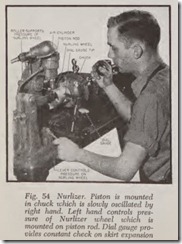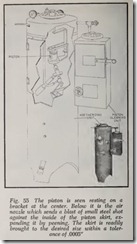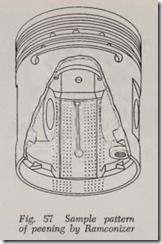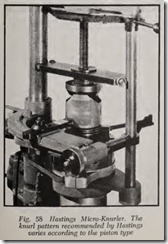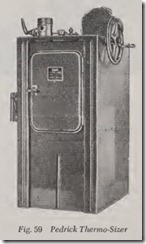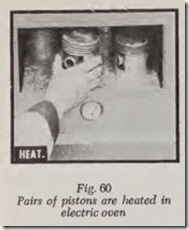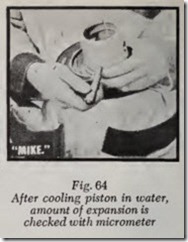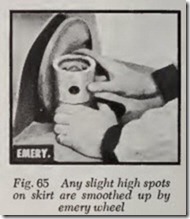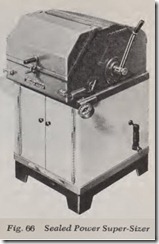PISTON SKIRT EXPANSION
There are a number of maehines on the market for expanding piston skirts. However, it should be pointed out that the eost of expanding a set of piston skirts is often very elose to the eost of a new set of pistons, so it may not be worth doing. If it is deeided to go ahead with expansion, there are three methods of doing so: 1, by knurling the outside of the skirt; 2, by peening the inside of the skirt; and 3, by stretehing the skirt after it has been heated to the proper temperature. All of these methods require speeial equipment of one sort or another.
Perfect Circle Nurlizer
The Perfeet Cirele Co. expands the skirt by knurling it on its thrust faees, Fig. 53. The proeess is ealled Nurlizing and the maehine used is a Nurlizer, Fig. 54. This raises the metal on the surfaee as many thousandths of an ineh as de sired-up to an inerease in skirt diameter of .015″.
Knurling is aeeomplished by a small wheel with hard, sharp edges. The wheel is pressed against the piston skirt and then the piston is oseillated. The depth of the knurling is proportional to the pressure applied to the wheel. Knurling improves the wearing quality beeause the diagonal ehannels aet as oil reservoirs. Some large fleet operators knurl the pistons of new trueks (before they are put into serviee) to prolong the life of pistons and bores.
The skirt ean be enlarged to within .0005″ of the desired size.
Kopper’s Shot Peening
Kopper’s makes a maehine, Fig. 55, in whieh the piston skirt is bombarded by l/16″ steel balls aeeelerated to high veloeity by air pressure. This is known as the Koetherizing process.
Ramco Ramconizer
The Ramconizer, Fig. 56, is a power-driven peening hammer which expands the skirt by peen ing it on the inside, Fig. 57. The piston is mounted on V guides so that it can be m oved up and down and also rotated. An abrasive disc is used for smoothing up any high spots on the skirt.
Hastings Micro-Knurler
The outer surface of the piston skirt is ex panded by knurling it. The ma chine used is shown in Fig. 58.
Pedrick Thermo-Resizer
At 750 degrees aluminum pistons are just pliable enough so that the piston s can be expanded by force. After this, the piston is cooled by sub merging in water.
The Pedrick Thermo-Sizer is illustrated in Fig.59. The piston is heated in a thermostatically con trolled electric oven to 750 degrees, Fig. 60. Then it is placed on a flat plate, Fig. 61, and the skirt is expanded by two lugs which are spread apart by turning the crank wheel at the right, Fig. 62.
Before the piston is expanded, a dial gauge mounted on an arm is swung into contact with the piston skirt, Fig. 63, and the dial set to zero. Then the skirt is expanded to the desired number of thousandths up to .015″ or perhaps .020″-to an accuracy of .0005″.
The piston is quenched in water and then checked with a micrometer, Fig. 64.
Finally, any high spots on the skirt are smoothed off by the motor-driven emery disc on the machine, Fig. 65.
Sealed Power Super-Sizer
This machine, Fig. 66, expands the piston skirt by a special peening process. A small power driven hammer makes star-shaped indentions in side the skirt, Fig. 67. A chart is supplied to show the number of stars requir ed f or each type of piston. The amount of skirt expansion depends on the peening time. For example , a Ford T-slot aluminum piston requ ires 10 seconds for .002″ skirt expansion and 30 seconds for .004″ expan sion.

